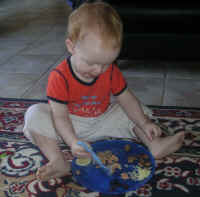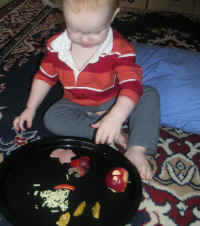Baby led solids - the easy way to
introduce solids at the perfect pace for your individual baby's needs!
Baby Led Solids is an
Exercise in TRUST . .
Baby led solids is basically an ongoing exercise in trust. It involves a
shift in approach- from being the person 'managing' the baby's eating, to one of
trusting the baby's instincts about what they eat, when and how much.
Considering the burgeoning levels of obesity, any way we can support baby's
natural appetite awareness, starting by breastfeeding to the baby's needs
(feeding to cue), seems the logical way to go. Mother nature has provided a
pretty good system.
Following a baby-led approach turns out to be reassuring, a personal
challenge and enlightening all at once. I have at times basically had to force
myself to accept Maven's natural awareness of his appetite, and this has
reinforced to me the importance, and safety net, of sustained breastfeeding. As
he gains so much of his nutritional needs from breast milk, he needs to only 'top
up' his diet with his whimsical toddler eating patterns. Most reassuring really,
not having to feel I should be coaxing him to eat all day. Instead, all that is
needed is to offer a wide range of options over the week.
What is it?
Baby led introduction to solids has only slight differences - but gee they
made logical sense to me, so we decided to go that way, and have been really
happy with how it is going.
The basic difference is minimal spoon feeding -
which is something that often happens anyway as toddlers decide to feed
themselves.
Baby led introduction of solids involves trusting the baby to know what it is ready or able to
eat, and to know when he has had enough.
I have found it quite interesting to
see that he really ate so little until a mental leap at seventeen months when he
began eating heaps. It is really easy, and a slow way to introduce baby/ toddler
to 'solids' - as it involves 'self feeding' , there is minimal spoon feeding.
Maven has very slowly increased his
intake - often he ate nothing. I provide a selection of this and that from what we
are eating, and he eats it or tastes it, after a while starts playing with it -
this was the sign he'd had enough.
It is a slow process, and I have found I have to learn to practise really
trusting his awareness of his needs, and so resist the urge to feed him
"have a bit of this, a bit more". I have and am learning about
social pressure to 'get him to eat' when it isn't really what he wants, so again
the trust factor comes back - he knows what he needs, and self manages his
eating rather than me having the responsibility for 'feeding' him - instead I am
responsible for offering variety, he is responsible for the eating part!
DO's and DON’Ts for baby-led introducing of solids
DO offer your baby the chance to participate whenever anyone else in the
family is eating. You can begin to do this towards the end of the sixth month.
Around this time most babies start showing an interest in watching you.
DO ensure that your baby is supported in an upright position while he is
experimenting with food. In the early days you can sit him on your lap, facing
the table. Once he is beginning to show skill at picking food up he will almost
certainly be mature enough to sit, with minimal support, in a high chair.
DO start by offering foods that are baby-fist-sized, preferably chip-shaped.
As far as possible, and provided they are suitable, offer him the same foods
that you are eating, so that he feels part of what is going on.
DO offer a variety of foods. There is no need to limit your baby’s
experience with food any more than you do with toys.
DON’T hurry your baby. Allow him to direct the pace of what he is doing. In
particular, don’t be tempted to ‘help’ him by putting things in his mouth
for him.
DON’T expect your baby to eat any food on the first few occasions. Once he
has discovered that these new toys taste nice, he will begin to chew and, later,
swallow.
DON’T expect a young baby to eat all of each piece of food – remember
that he won’t yet have developed the ability to get at food which is inside
his fist.
DO try rejected foods again later – babies often change their minds and
later accept foods they originally turned down.
DON’T leave your baby on his own with food.
DON’T offer foods which present an obvious danger, such as peanuts.
DON’T offer ‘fast’ foods, ready meals or foods that have added salt or
sugar.
DO offer water from a cup but don’t worry if your baby shows no interest in
it. A breastfed baby is likely to continue for some time to get all the drinks
he needs from the breast.
DO be prepared for the mess! A clean plastic sheet on the floor under the
high chair will protect your carpet and make clearing up easier. It will also
enable you to give back foods that have been dropped, so that less is wasted.
(You will be pleasantly surprised at how quickly your baby learns to eat with
very little mess!)
DO continue to allow your baby to breastfeed whenever he wants, for as long
as he wants. Expect his feeding pattern to change as he starts to eat more of
the other foods.
If you are bottle feeding, or have a family history of food intolerance,
allergy or digestive problems, DO discuss this method of introducing solids with
your health advisers before embarking on it.
Finally, DO enjoy watching your baby learn about food – and develop his
skills with his hands and mouth in the process!
Source: baby
led intro to solids guidelines
My Insights into baby led solids
into baby led solids
His instincts - he wouldn't
eat it if it his system wasn't ready for it
I liked the concept that if he couldn't physically eat it, it was too early
for his system. I found it interesting that if I was concerned about giving him something, it
was too soon - if I wasn't , it was okay. Trusting the instincts again. I
certainly felt like six months was too soon for him, eight months was more like
it for him. From the context of thinking what early peoples did, that makes
sense - no pureeing tools really, some pre-chewing, some mashing of foods, but
basically if it wasn't suitable baby couldn't eat it, so they breastfed for a
full length of time, which is the 4 - 7 years thought to be 'physiological'
breastfeeding duration (Ironically this is when the 'milk teeth' begin to be
replaced, too!).
An enlightening read is "A
Natural Age of Weaning" at http://www.kathydettwyler.org/detwean.html
The growth of different
teeth changed the way he ate
As he has grown molars, he is now eating differently. As each type of teeth
emerged he has eaten differently - more variety, more volume of foods, though
always breast milk is the base.
Breast milk first and always
a milk 'chaser'- his insurance policy
I always felt compelled to breast feed him before and after, and have assumed
this is a natural instinct to protect his system from any 'bugs' in the food! As
breast milk is packed with white blood cells, antibodies, antifungals,
antimicrobials, all sorts of immune building elements, (there is said to be a million
white blood cells in each DROP of breast milk), it is pretty certain where this
instinct comes from! He still always has a bit of milk after food at two years
of age, just as he did when he started. Some time about 18 months he would eat
before having breast milk, rather than before and after as he had done earlier.
Solids and sleep patterns -
no change
Solids made no difference to his sleeping patterns - except perhaps to be
more fidgety after meat at night - I recently learnt that meat proteins contain
an enzyme that fires up the brain and stuffs up sleep. Must experiment with that
one for myself!!!!
I had
iron issues, so wanted to avoid that with Maven, hence waiting into the 7-9
month window for introducing solids - evidence shows this will mean he has
higher iron levels as a child. He ate so little anyway...
Offer everything, regardless
of whether baby eats it, just for familiarity
A useful strategy I decided to adopt from the
start was to always offer a bit of all the suitable foods we were eating -
regardless of whether he ate it or not. For instance we might have chicken
schnitzel and mash, peas, carrots and gravy - Maven would have some chicken,
mash, a few peas and a bit of soft carrot. He would eat - the
chicken!!
Another time, he'd eat the chicken and some
mash, then one day start eating the carrot! I was working from my theory that
although he didn't eat it, it was always there, so it seemed 'normal' food to
him, - familiar. That way, one day he'd just eat it, rather than not offering it
as he didn't seem to ever eat it, then showing him this 'new' food, probably when
he is a toddler in the throws of 'neophobia' - and "NO!" being the
result! It has been a great strategy, though I tend to 'clean up' his food,
which was fine in the stages before about eighteen months when I would just pull
some food off my plate to feed him, and thought, well if he doesn't eat it now,
he can have it later as breast milk! Now that he has his own food (though I tend
to still give him food off my plate) all this picking is probably not too good
for the waistline! LOL I read somewhere that this sort of 'picking' can add four
kilos (8 pounds) over a year! Yikes!
How we came across this concept
I was researching the importance of delaying until at least 6 months for all
those reasons related to their 'open gut' at kellymom,
and meanwhile wondering what early
cultures did, researching that - it seems the fossil record shows that babies
through history were exclusively fed breast milk between six months and a year,
or longer. (source - our babies, ourselves) Research is showing up to two years
is fine! I was suspicious of the 4 months exclusive breastfeeding directive from
the 'new mums' class I attended, (already knowing six months was the minimum) as
the information about this, along with some carefully worded scare tactics, was
directly from a baby food company (a nice shiny brochure) who conveniently had
food to sell me. As one who is hot on avoiding being manipulated by shiny
advertising aiming to sell me something, and knowing the risks of too-early
solids, I was surprised to be the only one who seemed to think the pamphlets
were a conflict of interest, and would not take one home!
"Food is for fun until they are one (or until
they need it!)"
I decided to trust in the liquid gold of breast milk
until he showed a
preference otherwise - when he needed more than it provided, he would eat, which
I assumed would naturally happen! - “Food is for fun until they are one” was
the mantra I said to myself as he ate sooo sporadically – a taste a week from
when he first ‘ate’ (swallowed) at about eight months, then a bit every few
days, then a bit each day - about a teaspoon until eleven months, then about a
tablespoon here and there until fourteen months, then he began eating each
'meal', then eating (wanting) a lot at 17 months, but not always. If I didn’t
feel like feeding him food, the boob was enough, he went through stages of boob
only for days, and always when teething no food, this was fascinating to
observe. It becomes really obvious when he does want to eat – he’ll be
crystal clear about it! Towards two he ate differently again, as his back molars
came in, yet there are certain things he still doesn't eat, green leafy veg for
example. I have read (will try to find the link) that such are the last things
our digestion is capable of dealing with, due to the fibres.
How he ate
His first food was a bit of egg yolk off my finger. He loved eating fatty
stuff (animal fats) like the fat from cooked meats I waited with all those
'usual suspects' - dairy, wheat, egg white etc until after one, started with
cheese. He had yoghurt earlier, as it is altered. He had cheese at eleven months
ok - I read the lactose is changed in that as well. It was always at his
interest, so lots of titbits on his tray, or off our plates, or on his 'pick
platter'
- I'd do things like fill an egg carton with bits of stuff for him to pick
over, or put bits on a tray on the floor - we'd eat together.
- Or put bits of what we were eating all over his tray to taste (plus
whatever else was on hand)
- crackers and dips were a toddler hit. Hummous is a winner!
- I'd steady the spoon for soups or yoghurt (all he had for a while was
chicken home made stocks. All goodies in it)
- Soon enough he was spoon feeding himself without spilling it all! I'd fill
the spoon, hold it near his hand, but steady the end - if that makes sense. Now
he likes to feed me!
- I found it interesting that when I felt the urge to 'get food into him' he
wasn't interested, and I'd realise it was my expectation (based on some cultural
pressure, which I'd stop!) He was fine managing his own eating...
- I grated veg into bolognaise - he loved picking up the bits off his tray. -
He loves fried rice (I think the soy sauce (over one)) He loves Chickeny Rice -
rice with chicken fat in it! I put in grated cheese - loves it, whatever vegies
are in the eating...
- Fruit I cut up big bits of apple or orange, or peel it a bit and give him
the whole thing - he'd eat heaps that way.
- funny, but he hated banana, avocado - those early food choices liked by
many babies? Never ate the cereals, but I skipped them - wheat sensitivity.
Skipped the iron fortified cereals - there is evidence they hinder iron
absorption from breast milk once introduced.
- He ate from our plates until around 15 months, when we started giving him
his own at times.
- for lunch we would often (and still do) have a 'pick platter' - a round
tray with all sorts of tempting morsels on there, that we would both eat
together. Great fun putting it together, and we would pick over it during the
day as well.
I also found this page useful for ideas, though I don't consider Maven is a
picky eater, but that he has normal eating patterns.
Feeding toddlers: 17 tips for picky eaters www.askdrsears.com/html/3/T030800.asp
This 'pickiness' is called "Neophobia", and is an evolutionary
mechanism to protect the toddler from unknown, possibly dangerous foods. Hence,
having him eat from our plates is a sure-fire way he will eat, even if he has
the same foods on his plate - ours is obviously 'safe' as we are eating it, and
so he naturally wants to do this. I wonder how long it will go on? I understand
'neophobia' (fear of the new!) peaks at around 2.5 years.
Concern over premature weaning
I was so worried about interrupting breastfeeding, that a baby-led approach
was perfect. I observed / learnt from others that current 'advice' on when and
how much solids is designed to achieve weaning by twelve months (usually earlier
is the result) So much food is given to babies they have no space for milk, and
then all the risks of early weaning, such as the constant runny nose from a lack
of immune system support. I wasn't interested in dealing with a needlessly sick
child, so this has worked out well for us. I knew 10-14 months was a risk tim
for early weaning, as they are so busy, so I was careful to support his feeing
as a priority.
That age range is also a common time for 'nursing strikes' or 'breast
refusal' (also, not really so curiously, 'potty pauses! '), so knowing about
managing these was helpful. A useful article is this one from the Natural Child
Project, 'Is my
baby on a nursing strike?'
How practicing EC supported this approach
- As soon as anything effected the other end, I cut it out, this
meant I wanted to keep it all soft out the other end so that he didn't have to
strain - so the baby-led eating managed that, as he would get bored of eating /
have had enough after a really short time, and this seemed to correlate to what
his system needed. We'd say he ate like a fish - whatever he could eat in 5
minutes, as that is what he seemed to do! As soon as he started playing with it,
that was the end of his meal - he'd had enough. Of course, one of the benefits
we get with EC is the immediate feedback if something doesn't agree with their
system yet - there will be a pretty quick 'elimination' response if his system
wasn't ready for it. For example, the pineapple story (Read
a description of Maven's reaction when pineapple was introduced at around 12
months)
- I've noticed that as I tend to give him the same foods for a
few days, this helps him adjust - when we are having odd foods and lots of
foods, he'll have more accidents, if similar, better signalling and continence.
As his system hs matured, he has eaten more variety. It is interesting to note
that certain digestive enzymes are not produced in their systems until around
eighteen - twenty four months, and it was around eighteen months that he became
fully independent for poos (before then I would hold him over a toilet), and
also, what he was eating no longer made much difference to his timing. Basically
it became like regular stuff about then. (and goodness I'm glad I don't have to
wipe it off his body.)
Helpful resources supporting baby-led eating that I found
useful:
Kellymom.com such as "Solid
foods and the breastfed baby / toddler"
World Health Organisation such as "Exclusive
Breastfeeding for six months"
ABA such as "Just
breast milk, thanks!"
"Guidelines for implementing a baby-led approach to the
introduction of solid foods"
http://www.borstvoeding.com/voedselintroductie/vast_voedsel/rapley_guidelines.html
Wikipedia: Baby
Led Weaning entry.
A bunch of ABA
mums use a baby-led solids approach.
Baby Led weaning Blog http://babyledweaning.com/
Baby Led Weaning Yahoo Group: http://groups.yahoo.com/group/B-LW/
Learn
Part Time Elimination Communication (EC)
- how we all get started!
Back to top Tribal Baby © 2009 Charndra Josling
|
 Tribal
baby
Tribal
baby
 .
. into baby led solids
into baby led solids

